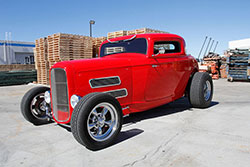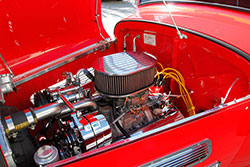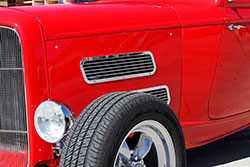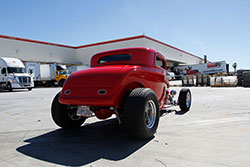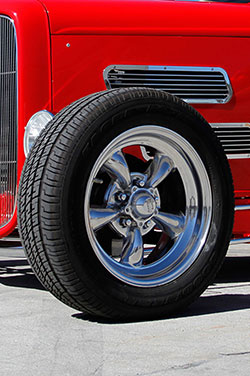Custom 1932 Ford Roadster Build Becomes a Huge Hobby for Retiree Gary Barnard
- 12 May 2016
Gary Barnard, 64-year old resident of Moreno Valley, California, is a car builder, of sorts. Unlike restoring cars, custom-built cars are mostly made from scratch. In other words, very little about the car ever existed before construction starts on it. You can say that it comes straight from the imagination of the builder.
Barnard has been constructing cars for about five or six years. However, he has been involved with cars most of his life. “My older brother and I went to drag races and we got really involved in it,” he said. “During that time I got to know a lot of guys involved in racing real well. When these guys were getting to retirement age they went into building street rods and that’s how I got into building.” He collected a lot of experience building cars working for Dan Gurney right after high school. “They trained me to build cars and motorcycles,” he said. “I built Indy Cars and AMA dirt track motorcycles. I built those things for five or six years, then I left and became a land surveyor.”
He was a surveyor for 37 years, but he also did fabrication work as a hobby at his home. He’s retired now, but continues to build cars in his garage. Originally, a hobby, it has now become a fulltime gig. Barnard noted that he has constructed three custom cars in recent years –- a 1932 Ford three-window coupe and two ‘32 roadsters. The 3-window is his pride and joy and he doesn’t intend to sell it. He drives the car on weekends, to Bakersfield, California twice a year to participate in hot rod shows, a distance of about 500 to 600 miles; and he also drives to Orange County, California quite a bit, which is a distance of 50 or 60 miles. His experience constructing cars helped to make this Blue Oval project somewhat of an easy undertaking. “I already knew what I wanted it to look like,” he said. “It’s fenderless and has three windows. I stretched out the wheelbase 3-inches so it rides a little better.”
He added that he attends car shows to get some ideas. He got the frame dimensions from Wescott Fiberglass, and then he started the project by laying out the chassis on a piece of plywood. He then created the dimensions of the car by setting up stamped form frame rails he purchased from ASC around it, and then built a jig. He included a Super Bell 4-inch drop axle and added coilover brackets to it as well as coilover brackets to the narrowed 9-inch rearend. He filled the rearend with Dutchman 31 spline axles and a nodular Iron positraction third member. “I wanted to make the suspension different and that’s what has attracted a lot of attention,” he said. He also made the aluminum hood sides and side vent grills. He sells the vents to anyone who wants a set. The car also features a small block Chevrolet crate engine from GM Performance Parts. “I left the engine relatively stock, but I wanted to boost the horsepower a bit. The engine generated 290 horsepower. I improved that by pulling out the cam and replacing it with a Lunati cam, lifters, and springs, Edelbrock manifold and carburetor, and Mallory UniLite distributor. It runs real good and generates more than 300 horsepower,” he said. Sitting atop the Edelbrock carburetor is a K&N E-3471 air filter to finish off the clean look of the engine. His garage can accommodate three and a half cars. So it’s big enough to host the tools and machinery he needs to manufacture parts. The work area includes a lathe, disc mill grinders, hydraulic tube bender, two TIG welders, two drill presses, and cutoff saws. If he doesn’t have the proper tool or machine to make a part, he knows people who build AMA dirt bikes in Costa Mesa, California who can help. “They have a full machine shop I can use, but I haven’t had to except once or twice when my lathe capacity wasn’t big enough. Other than that, I do everything in my garage,” he said. Getting parts that he didn’t build was not a problem, explained Barnard. “Being in Southern California I have access to pretty much all that stuff. However, 90 percent of the parts I used I bought online. I selected parts from manufacturers I know. Having been involved in this in some way or another for so many years, I know what is good stuff. Most of the streetcar stuff that’s good is racecar oriented.”
“Most of the stuff I tried my best to make instead of buying,” he added. “I discovered that 95 percent of the stuff you buy at street rod shops is expensive. I can make the parts myself for one-tenth the cost. It is really cheap to build a car if you do everything yourself.” “I did the interior myself. Upholstery that had to be sewn –- armrests and one-piece headliner -- was done by a local upholstery shop,” Barnard added. He only confronted two problems –- moving the car around the garage as he was building it and installing the air conditioner. “The body of the car alone weighs about 350 pounds, so it was hard for me to move it by myself. The air conditioner was a problem because the console of the car is thin and includes all the controls. I didn’t realize that since the air conditioner’s controls had to be put into the console, the unit and the console had to go into the car at the same time. The air conditioner is real big and bulky and it had to go in right under the dash. It turned out that if the air conditioner was a half-inch longer one way or the other, it wouldn’t have fit in the car and I would have had to start all over again.” According to Barnard, construction of the 32 Ford took more than two years. “The body was tied up for six months getting painted by an auto body shop. Except for that, it took about one and a half years to build,” he concluded. |
||||||
|
||||||

